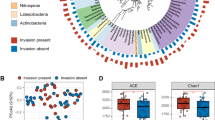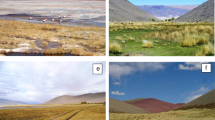Abstract
The difference between the mycobiota in anthropogenically transformed soils of the settlements of the 9th–14th centuries and in the background zonal Podzols and umbric Albeluvisols of the middle and southern taiga subzones in the European part of Russia is demonstrated. The mycological specificity of anthropogenically transformed soils with a cultural layer (CL) in comparison with the background soils is similar for all the studied objects. Its characteristic features are as follows: (1) the redistribution of the fungal biomass in the profile of anthropogenically transformed soils in comparison with zonal soils, (2) the lower amount of fungal mycelium in the CL with the accumulation of fungal spores in this layer, (3) the increased species diversity of fungal communities in the CL manifested by the greater morphological diversity of the spore pool and by the greater diversity of the fungi grown on nutrient media, (4) the change in the composition and species structure of fungal communities in the CL, (5) the replacement of dominant species typical of the zonal soils by eurytopic species, and (6) the significant difference between the fungal communities in the CL and in the above-and lower-lying horizons and buried soils of the same age. Most of the mycological properties of the soils of ancient settlements are also typical of modern urban soils. Thus, the mycological properties of soils can be considered informative carriers of soil memory about ancient anthropogenic impacts.
Similar content being viewed by others
References
Archeology of the Komi Republic, Ed. by E. A. Savel’eva (DiK, Moscow, 1997) [in Russian].
N. Brunnek, The Serpukhov Region is Our Native Land (Serpukhov, 2004) [in Russian].
L. A. Vorob’eva, Chemical Analysis of Soils (Mosk. Gos. Univ., Moscow, 1998) [in Russian].
M. I. Gerasimova, M. N. Stroganova, N. V. Mozharova, and T. V. Prokof’eva, Anthropogenic Soils: Genesis, Geography, and Remediation (Moscow, 2003) [in Russian].
A. A. Gol’eva, Extended Abstract of Doctoral Dissertation in Geography (Moscow, 2006).
Scientific Methods of Studying the Occupational Layers of Old Settlements (NIA-Priroda, Moscow, 2004) [in Russian].
K. M. Zaprometova, T. V. Shemshur, and T. G. Mirchink, “Identification of Soils Using the Structure of Complex of Typical Soil Fungi,” Biol. Nauki, No. 5, 95–98 (1987).
A. E. Ivanova, O. E. Marfenina, E. E. Kislova, and E. P. Zazovskaya, “Mycological Characteristics of the Cultural Layer of a Medieval Settlement on Soddy Calcareous Soils,” Pochvovedenie, No. 1, 62–71 (2006) [Eur. Soil Sci. 39 (1), 53–61 (2006)].
A. B. Kul’ko, Extended Abstract of Candidate’s Dissertation in Biology (Moscow, 2000) [in Russian].
O. E. Marfenina, Anthropogenic Ecology of Soil Fungi (Meditsina Dlya Vsekh, Moscow, 2005) [in Russian].
O. E. Marfenina, E. V. Gorbatovskaya, and M. V. Gorlenko, “Mycological Characterization of Occupation Layers in Old Russian Settlements,” Mikrobiologiya 70(6), 855–859 (2001).
O. E. Marfenina, A. B. Kul’ko, A. E. Ivanova, and M. V. Sogonov, “Microscopic Fungi in the Urban Environment,” in Mikol. Fitopatol. (Nauka, Moscow, 2002), Vol. 36, No. 4, pp. 22–32 [in Russian].
Methods of Soil Microbiology and Biochemistry: a Training Manual (Mosk. Gos. Univ., Moscow, 1991) [in Russian].
T. G. Mirchink, Soil Mycology (Mosk. Gos. Univ., Moscow, 1988) [in Russian].
Magguran, A.E., Ecological Diversity and Its Measurement (Croom Helm, London, 1988).
V. Ya. Petrukhin and T. A. Pushkina, “Prehistory of an Old Russian Town,” Istoriya SSSR, No. 4 (1979).
L. M. Polyanskaya, Extended Abstract of Doctoral Dissertation in Biology (Moscow, 1996) [in Russian].
Soil, City, and Ecology (Moscow, 1997) [in Russian].
Soils of Northern Europe (1989) [in Russian].
Laboratory Manual on Agricultural Chemistry, Ed. by V. G. Mineev (Mosk. Gos. Univ., Moscow, 2001) [in Russian].
I. A. Sokolov, Theoretical Problems of Genetic Soil Science (Gumanitarnye Tekhnologii, Novosibirsk, 2004) [in Russian].
V. O. Targulian, “Concept of Soil Memory: Development of the Basic Genetic Soil Science,” in Many Faces of Geography: Development of Gerasimov’s Ideas (to His 100th Birthday), Ed. by N. F. Glazovskii (2005), 114–131 [in Russian].
S. Ya. Trofimov, O. S. Yakimenko, S. N. Sedov, et al., “Composition and Properties of Organic Matter in the Soils of Ancient Slavic Settlements in the Forest Zone,” Pochvovedenie, No. 9, 1057–1066 (2004) [Eur. Soil Sci. 37 (9), 927–936 (2004)].
F. M. Khabibullina, “Soil Micromycetes of Blackberry-Green Moss Spruce Forest,” Lesovedenie, No. 1, 43–48 (2001).
K. H. Domsh, W. Gams, and T. H. Andersen, Compendium of Soil Fungi (Academic, London, 1993), Vol. 1.
O. E. Marfenina, A. E. Ivanova, and E. E. Kislova, “The Comparison of Mycological Properties of Anthropogenically Transformed Soils of Medieval Urban Centers and Modern Urban Soils,” in Abstracts Book of the 3rd International Conference “SUITMA 2005,” Cairo, Egypt, 2005 (Cairo, 2005).
J. A. Stulpers, “Identification of Wood-Inhabiting Aphyllophorales in Pure Culture,” Studies Mycol., No. 16, 1–149 (1978).
J. C. Zak, The Fungal Community, Ed. by G. C. Caroll and D. T. Wicklow (Dekker, New York, 1991), pp. 403–425.
E. Zazovskaya and M. Bronnikova, “Cultural Layers of Medieval Towns as a Result of Pedoantropogenic Irreversible Change in Soil System of Urban Environment,” in Proceedings of Conference on Soil and Archaeology, Szazhalombatta, Hungary, 2001 (2001).
E. P. Zazovskaya and S. N. Sedov, “Cultural Layers of Medieval Towns as a Result of Pedoanthropogenic Irreversible Change in Soil System of Urban Environment,” in Proceedings of the First International Conference on Soils of Urban, Industrial, Traffic and Mining Areas, Essen, Germany, 2000 (Essen, 2000), Vol. 1, pp. 311–317.
Author information
Authors and Affiliations
Additional information
Original Russian Text © O.E. Marfenina, A.E. Ivanova, E.E. Kislova, E.P. Zazovskaya, I.Yu. Chernov, 2008, published in Pochvovedenie, 2008, No. 7, pp. 850–860.
Rights and permissions
About this article
Cite this article
Marfenina, O.E., Ivanova, A.E., Kislova, E.E. et al. Fungal communities in the soils of early medieval settlements in the taiga zone. Eurasian Soil Sc. 41, 749–758 (2008). https://doi.org/10.1134/S1064229308070090
Received:
Published:
Issue Date:
DOI: https://doi.org/10.1134/S1064229308070090




